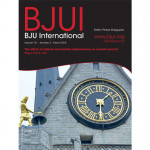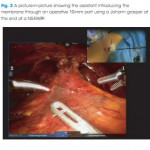Editorial: Nerve wrapping with biomaterials during radical prostatectomy to improve potency recovery
Radical prostatectomy is one of the standard treatment options for localized prostate cancer. The functional outcomes of radical prostatectomy are steadily improving along with better understanding of the surgical anatomy involved. Technological and technical advancements have helped improve continence outcomes significantly. High‐volume centres have consistently reported continence rates of >95% 1; however, potency recovery is the major limiting factor in achieving trifecta, even with full nerve‐sparing. Neuropraxia secondary to surgical dissection is one of the factors delaying potency recovery. We were the first to introduce the concept of protecting the neurovascular bundle using a wrap. In 2015, we first published our work on dehydrated human amnion‐chorion membrane (dHACM) nerve wrapping, a potential means of improving functional outcomes after radical prostatectomy 2.
Clinical applications of biomaterials are increasingly being explored. Their biological and physiochemical properties influence their role in peripheral nervous system regenerative therapy 3. Amniotic membrane graft has multiple growth factors including epidermal growth factor, vascular endothelial growth factor and anti‐inflammatory chemokines and cytokines including interleukin (IL)‐1, IL‐10 and IL‐1ra. In vitro and in vivo studies have reported that dHACM minimizes the surgical trauma‐induced inflammation and peri‐neural adhesions. These membranes are commercially available in various sizes for clinical use.
Porpiglia et al. 4 have reported their work on chitosan membrane application on the prostatic neurovascular bundle. Their phase II study is a step towards finding an ideal biomaterial favouring peripheral nerve healing. Chitosan is another potential biomaterial made of glucosamine and N‐acetyl glucosamine polymer which are natural components of mammalian tissues 5. Chitosan is hypoallergenic and only transiently stimulates the immune system and ultimately becomes bio‐tolerated and metabolized. It is not possible to develop specific antibodies against it because there are no proteins and lipids in its structure. Chitosan has inherent antimicrobial activity as its positive loads destabilize the membrane integrity of microorganisms. The inherent haemostatic and antimicrobial action of chitosan favour its application in wound healing. Chitosan has been extensively researched as a carrier molecule for biologically active particles and a scaffold in tissue engineering. Porpiglia et al. 4 have reported the safety and feasibility of its application for neurovascular bundle wrap during radical prostatectomy. In their non‐comparative study, they observed 96.4% continence and 68.6% potency recovery within 6 months. Comparative clinical trials are recommended to study its advantages in both partial and full nerve‐sparing settings. Membranes were manufactured from chitosan solution and sterilized for the purposes of the study. Pending approval by the regulators, study in other centres using chitosan membrane may be challenging.
The urological community has long been searching for ways to optimize functional outcomes after radical prostatectomy. Even for an ideal candidate with full nerve‐sparing, potency recovery is not assured. Several technical and technological modifications are being explored to address this concern. Bio-materials hold potential, and further exploration is warranted in the form of multicentre and randomized trials.
- 1 Patel VR, Abdul‐Muhsin HM, Schatloff O et al.Critical review of ‘pentafecta’ outcomes after robot‐assisted laparoscopic prostatectomy in high‐volume centres. BJU Int2011; 108: 1007–17
- 2 Patel VR, Samavedi S, Bates AS et al.Dehydrated Human Amnion/Chorion membrane allograft nerve wrap around the prostatic neurovascular bundle accelerates early return to continence and potency following robot‐assisted radical prostatectomy: propensity score‐matched analysis. Eur Urol2015; 67: 977–80
- 3 Dalamagkas K, Tsintou M, Seifalian A. Advances in peripheral nervous system regenerative therapeutic strategies: a biomaterials approach. Mater Sci Eng C Mater Biol Appl2016; 65: 425–32
- 4 Porpiglia F, Bertolo R, Fiori C, Manfredi M, De Cillis S, Geuna S. Chitosan membranes applied on the prostatic neurovascular bundles after nerve‐sparing robot‐assisted radical prostatectomy: a phase II study. BJU Int2018; 121: 473–9
- 5 Rodríguez‐Vázquez M, Vega‐Ruiz B, Ramos‐Zúñiga R, Saldaña‐Koppel DA, Quiñones‐Olvera LF. Chitosan and its potential use as a scaffold for tissue engineering in regenerative medicine. Biomed Res Int2015; 2015: 821279



